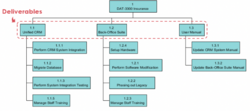Implementation of the SDGs in the Construction Industry
In September 2015, 193 world leaders came together with a vision to transform our world to the better. They came to an agreement of 17 global goals for sustainable development (SDGs), with the aim to make an end to extreme poverty, inequality and climate change by 2030. In the pursuit of reaching these goals, it is inevitable for business to take action. One essential thought behind these goals is to make them famous, so that we all have a common goal and know what we are fighting for.
The building industry is responsible for 30% of the total global resources, 40% of global energy consumption and up to 30% of the total global greenhouse gases. In addition, the building industry is considered to be the industry that could potentially reduce its energy consumption with the lowest cost. However, the question is how to implement the SDGs in construction.
The SDG compass presents five steps that assist companies in maximizing their contribution to the SDGs: understanding the SDGs, defining priorities, goal setting, integrating sustainability and reporting and communicating.
Contents |
History
SDG compass
Understanding the SDGs
Countries are struggling to translate the SDGs into meaningful and efficient action at the national level. They all need to identify what policy implication of the SDGs are for them. Therefore, some countries report, they have not made much progress in terms of taking action. It is, however, crucial for the implementation of the goals, countries learn from each other’s experiences.
Goals and targets will support or conflict one another, depending on geography, governance arrangements and technology. It is important to understand the interactions between goals and targets, identifying where key trade-offs lie, and also where different goals reinforce each other in order to develop smart policies. However, having different ministries and planning agencies discussing priorities is likely to be an unruly process. This is where a common language and framework may come in handy.[1]
In an interview with UN Tribune, Martin Edwards said: “I worry about promising action on climate while promising sustained economic growth and full employment while increasing access to energy all at the same time. We might not be able to get everything here, so our attempt to advance some goals might come at the expense of others.”[2]
The initial step for every business is to familiarize themselves with the SDGs and understand the opportunities and responsibilities they represent to the business. By aligning their priorities with the SDGs, companies avoid being exposed to growing legal and reputational risks. Furthermore, they will improve trust among stakeholders and resilience to costs or requirements imposed by future legislation.
The SDGs are expected to be an extremely helpful tool in the creation of more effective partnerships with governments, civil society organizations and other companies. This is because of the common language the SDGs create, which help companies communicate in a more consistent and effective way with stakeholders about their impact and performance. [3]
Defining priorities
The 17 SDGs represent targets and goals which aim towards a somehow perfect world, but not all of them are equally relevant for a company. Each individual company should conduct an assessment on the current, potential, positive and negative impacts they have on the SDGs and the likelihood of future ones. A way to conduct this assessment is by doing a high-level mapping of their value chain, where areas with high likelihood of either negative or positive impacts on the issues that the SDGs represent are identified, see figure XX.[3]
To map high impact areas, certain tools and methodologies are available:[3]
- Life Cycle Assessment (LCA) methodologies
- Environmentally-extended input-outpot (EEIO) models
Some tools can be applied to specific SDGs:[3]
- GHG Protocol Scope 3 Evaluator
- The social Hotspots Database
- The Human Rights and Bussiness Country Guide
- WBCSD Global Water Tool
- Poverty Footprint Tool
Priorities in the building industry
Setting goals
Setting goals in the building industry
Integrating
Engaging in partnerships in the building industry
reporting and communicating
Benefits
Limitations
References
Several references are directly linked in the text through its key word.